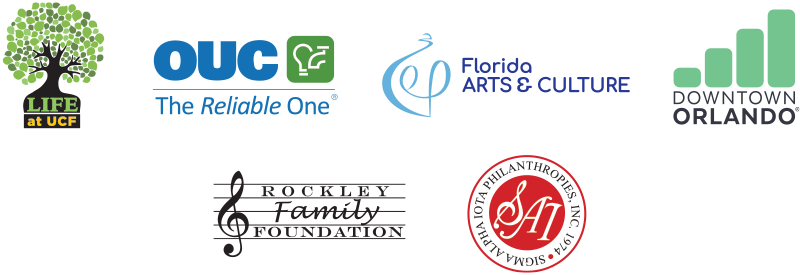-
Monday, Apr 7, 2025, 7:30 p.m.
- Steinmetz Hall
- Purchase Tickets
- Jump to Program
The UCF Percussion Ensemble partners with Brazilian composer Ney Rosauro, Francisco Abreu, Tutti Choir Brasilia, and the UCF Singers for an electrifying evening of music.
-
Monday, Apr 7, 2025, 7:30 p.m.
- Steinmetz Hall
- Purchase Tickets
- Jump to Program
Get ready for an electrifying performance as the UCF Percussion Ensemble and Ney Rosauro, Francisco Abreu, Tutti Choir Brasilia, and the UCF Choir take the stage for an evening of percussion music.
In addition to featuring the UCF Percussion Ensemble on the first half, the second half will be a special presentation of a new piece for solo percussion, percussion ensemble, and choir by Brazilian composer Ney Rosauro. The performance will be conducted by Rosauro and will be presented in collaboration with Francisco Abreu, solo percussion, the Tutti Choir Brasilia, and the UCF Choir.
This featured concert comes at the culmination of a full day of percussion ensemble activities in Steinmetz Hall as we host the Percussive Arts Society Percussion Ensemble Competition and Festival, which featured percussion ensembles from around the state of Florida. The event was cliniced and evaluated by Marcelina Suchocka and Jeff Moore.
UCF Percussion Ensemble
Thad Anderson, director
Scroll Manuscript by Thad Anderson
Colored Windows, Tempered Rooms by Baljinder Singh Sekhon
To Varese by Joseph Tompkins
featuring Marcelina Suchocka, multi-percussion
The First Circle by Lyle Mays & Pat Metheny, arr. Rivera, Kingan, & MacDonald
featuring McClenty Hunter, drum set
Intermission
Brazil, Symphonic Poem in 12 Movements by Ney Rosauro
Ney Rosauro, conductor
Francisco Abreu, solo percussion
Cristina Carvalho, piano
Charlie Storch, double bass
Tutti Choir of Brasilia, Daniel Moraes, director
UCF Choir, Kelly Miller, director
About the Artists
The UCF Percussion Ensemble, under the direction of Thad Anderson, offers students well-rounded experiences in all facets of ensemble playing. The ensemble presents audiences with varied programs that feature significant works for idioms such as chamber, mallet, large, historic, and world ensembles. The group frequently works with composers to commission and premiere new works for percussion ensemble. Some of these recent projects have included collaborations with Marc Mellits, Tiffany Connell, Jonathan Kolm, John Psathas, Bill Ryan, D.J. Sparr, Paul Lansky, David Bennet Thomas, Charles Griffin, James Norman, and Zack Browning. The debut UCF Percussion album, Patterns, was released in 2014 and features new quartets for two marimbas and two vibraphones. The ensemble presented the New Literature for Percussion Ensemble session at the Percussive Arts Society International Convention in 2014 (Indianapolis, IN) and a concert of new music for clarinet and percussion ensemble at the 2017 International Clarinet Association ClarinetFest (Orlando, FL).
Born in Bialystok, Poland, Marcelina Suchocka is the Principal Percussionist for Sarasota Orchestra and the Britt Festival Orchestra. Marcelina enjoys a diverse career spanning orchestral, chamber, new music, and solo playing. She was a fellow at the New World Symphony in Miami Beach and has performed as an extra/substitute percussionist with the New York Philharmonic, Los Angeles Philharmonic, Cleveland Orchestra, Boston Symphony, Chicago Symphony, National Symphony Orchestra, Dallas Symphony, Detroit Symphony, Kansas City Symphony, Florida Orchestra, and the Utah Symphony. Marcelina has spent summers as a fellow at the Tanglewood Music Center, Pacific Music Festival, the Music Academy of the West, National Repertory Orchestra, and Spoleto Festival. Marcelina has performed as a concerto soloist with the Chicago Symphony performing the Koppel Marimba Concerto. She is a founding member of Excelsis Percussion Quartet and Pathos Trio, and performs locally with ensemblenewSRQ.
McClenty Hunter is a Grammy-nominated drummer who has worked with jazz icons such as Lou Donaldson, Cedar Walton, Jimmy Heath, Kenny Garrett, Buster Williams and Curtis Fuller, among others. In the August 2019 edition of Downbeat magazine, McClenty has been acknowledged as a rising star, as well in Modern Drummer magazine Readers Poll 2017 and in February 2016 edition of Modern Drummer. In 2017, McClenty debuted as a leader and composer on The Groove Hunter (2017) receiving 4 stars in Downbeat magazine, with a raving review in Modern Drummer, among others. His masterful work can also be heard on several notable recordings: Dave Stryker’s hit records Eight Track series (2019), The Stryker & Slagel Band’s Expand (2016), Dave Styrker’s Messin With Mr. T (2015), Javon Jackson’s Live at Smoke: Expression (2013) and Kenny Garrett’s Grammy-nominated LP Pushing The World Away (2013). McClenty is an Assistant Professor in the UCF School of Performing Arts where he coordinates the jazz drum set studio and teaches ensembles and courses in jazz.
A native of Rio de Janeiro, Brazil, Ney Rosauro is considered one of the most important composers for percussion of the 20th century. In 2023 he was inducted to the Hall of Fame of the Percussive Arts Society. With his unique style of writing, which combines charming melodies with catchy rhythms, Rosauro utilizes the rich elements of Brazilian folklore to create stylized compositions that are full of life and fantasy, and has been enchanting audiences all over the world. His 100-plus compositions and method books are standards in the percussion repertoire. Rosauro’s first marimba concerto is arguably the most popular percussion concerto and has been performed thousands of times by distinguished orchestras worldwide. His 11 CDs have been hailed by critics, percussionists, and general music-lovers alike. Ney has given solo recitals and appeared as a soloist with orchestras in more than 45 countries, and has presented workshops/residencies at some of the world’s most prestigious conservatories and universities.
Francisco Abreu, symphonic percussion teacher at the Brasília School of Music, is characterized by the diversity of his musical education and performance. He has participated in courses and masterclasses with renowned percussion and drumming exponents, holds master’s degree in music from the University of Brasília (2022-2023), and graduated in percussion from UFSM/UNESP under the guidance of professors Dr. Ney Rosauro and Dr. John Boudler (1999-2003). He also specialized in mallets with Emanuel Sejourné at the Conservatory of Strasbourg, France (2004). Currently, as a professor/coordinator of Percussividade – EMB Percussion Ensemble, he conducts research on percussion learning and contemporary music. In November 2023, they performed his composition at the largest Western percussion event, the 48th PASIC – Percussive Arts Society International Conference, as part of the New Music Research Presents program in Indianapolis, USA. He is also a prolific composer and his pieces have been presented in South and North America and Europe.
The Tutti Choir Brasilia includes professional and amateur singers and currently has over 70 singers. Tutti was founded in late 2016, with the support of Soncietà, a music production company from Brasilia, to participate in a concert of a premiere of a Brazilian work, “Missa de Alcaçus”, by Danilo Guanais. The concert took place in May 2017, on the stage of Carnegie Hall, in New York City, United States. On that occasion, the group met with the Chamber Choir of Campina Grande, Paraíba. It also performed on the same trip, at the Church of Our Lady of Pompeii. In November 2018, he toured Europe. In Frankfurt, Germany, he sang with two other choirs that promote Brazilian music in Germany. In Prague, Czech Republic, he participated in On Stage in Prague, an Interkultur project, together with other choirs from other European cities.
Personnel
UCF Percussion Ensemble
Zane Adams
Matthew Brandt
Rhys Carmenatty-Jones
Evan Carville
Joseph Cassidy
Sam Flores
Simon Giacalone
Emmaline Kealoha
Logan Newhouse
Skylar Pearson
Logan Ruch
Caleb Schmaus
Jacob Scott
Grace Singh
Jacob Timothy Suarez
Nathaniel Woodall
William Wright
Tutti Choir from Brasilia
Daniel Moraes, director
Cristina Carvalho, piano
Alessandra Fiorentini
Aline Coelho
Ana Luiza Costa
Beatriz Carvalho
Carol Morgante
Cândida Veloso
Glaucia Ferreira
Patricia Duarte
Piedade Couto
Raïssa Menezes
Regina Muniz
Rosa Cavalcanti
Rosemary dos Santos
Vânia Rodrigues
Andrea Gusmão
Ariadna Moreira
Beatriz Pinheiro
Diacuy Teixeira
Luciene Teodoro
Sonia Ribeiro
Susi Hiromi
Valéria Souza
Alexandre Damasceno
Amauri Neri
Francisco Bouissou
Hermano Villar
Nilma Nonato
Alex Marco
Daniel Moraes
Gilmar Araújo
João Pedro Burnett
Maurício Pires
João Pedro
Sidney Menezes
UCF Choir
Kelly Miller, director
Carlos Alvarez
Elias Andreopoulos
Miles Andrews
Kol Ball
Ollie Bost
Ivan Briones
Deyvan Bryant
David Burrows
Janet Ciaravino
Olivia Ciaravino
Emily Clemens
Joseph Dellutri
Sydney Duverneau
Johanna Estrella
Naisha Francois
Katherine Corvalho Gagno
Gabriel Garcia
Tayah Herrera
Christopher Jenkins
Julian Lopez
Kara Martin
Natalia Meretz
Jimena Monteagudo
Ryan Murphy
Melanie Pires
Shawnell Ramcharita
Isabel A. Rios
Luisa Rios
Gabe Salyer
Ashton Sarlo
Sylvia Scott
Joshua Simmons
Christopher Tarsita
Athan Huskey
Anthony Pino
Tyler Wheelhouse
Program Notes & Lyrics
Brazil by Ney Rosauro
A Symphonic Poem in 12 movements for Solo Percussion, Choir, and Percussion Ensemble Portuguese lyrics by Paulo Buffara
The symphonic poem “Brazil” is a musical journey that describes Brazil and its historical and cultural origins from its discovery to the present days. Brazil, its beauty, its cultural richness and its diverse music with beautiful melodies and contagious rhythms is described musically in 12 moments that represent events, characters and important moments in its history. With small excerpts narrated between the movements and intelligent, descriptive and humorous lyrics, the listener is led to a better understanding of the work and the musical context that each movement represents.
The work has a cyclical theme that serves as an element of unity and transition between the 12 movements. If we assign a letter of the alphabet to each musical note based on the note “Do” as the letter “A”, the note “Do#” as the letter “B” and so on, the word “Brazil” will be formed by the notes “Do#, Fa, Do, F#, G# and B” that together form a suspended Do# seventh chord. This chord and sequence of notes appears throughout the entire work.
Europe, Motherland
After the introduction with elements and variations of the cyclical theme, the first theme is presented by the flute and harp and recalls the ancient tradition of the old continent and the Iberian peninsula from where the Portuguese left to discover Brazil. The lyrics talk about the uncertainties beyond the sea andthe possibility (or not) of existing land beyond the horizon.
From Lisbon via the Tejo river, we reach the sea
But beyond the horizon, what is there?
Would it be worth to risk life seeking possible fortune
If the boat gets there…
It is said that there are riches, and that the Eldorado is there
Many birds that chirp gorgeous songs from this land
There are forests and waterfalls, fresh waters, green mountains
If such a place exists…
The Voyage of the Discovery
This episode describes the monotony of the journey, the uncertainty of sailing without knowing where, and the dangers of the ocean. The lyrics describe the different feelings of men and women separated by the ocean. The tension builds little by little, passes through storms and culminates in the glorious moment when finally land is in sight.
How mysterious it is to navigate. An obscure dream on the sea.
The port of departure is always further away
And the dream of arrival is always a horizon ahead
Storm, rough sea, could be the end
Calm sea, good winds, a happy landing.
Land in view,
It has tropical green forests, blue rivers, and exuberance,
Beauty like this, there is nowhere!
The Earth
The musical environment evokes the tropical forests, birds and waterfalls of the virgin land, and is embellished with lyrical melodies that describe the immensity and beauty of this newly discovered land.
What a beautiful land, covered in aromas and colors
Your beaches and forests reflect your beauty
Born of dreams of a new world, seeds sowed in gentle land
In your bosom I let myself be enchanted.
What a beautiful land, covered in aromas and colors
Your beaches and forests inspire my singing
The Indigenous People
The frantic rhythm of the drums represents the native inhabitants of the land who, according to their tribes, could be friendly hosts, terrible cannibals or headhunters. The sound of cannons and shots of “fire sticks” from white men will be heard at the end, representing the oppression and indiscriminate killing of the Indigenous people.
Ianomâmi, Pataxó, Tupinambá, Aimoré
Arawetê, Carijó, Xavante and Macuxí
Tupiniquim, Guarani, Kaxinauá, Caiapó
Pitaguarí, Caeté, Anauenê and Tupi
Tiberê, Guaraci, Tainá, Peri
Yamandú, Iberê, Mauricí
Tiarajú, Pitangui, Jurecê, Ceci
Moacir, Cairí, Jurema
White man, brought the fire stick and came to stay
Domination by the White Man
After killing the indigenous people the white man asserts his possession of the new land. Trumpets and Timpani announce the arrival of the “bandeirantes” that were the first explorers of the backlands who consolidate the white man’s dominance over the discovered land.
The First Villages
The sound of church bells and prayers sung inside them evoke the first settlements founded in the new land.
On the top of the hill, a church where the bell announces
That it is time for the mass and calls the people to pray
Shipwrecks and Exiles
In a satirical way the first inhabitants who came to live in the new discovered land are described here. They were almost all shipwrecks from ships sunk on the coast and also drunks, outlaws and criminals who were not welcome on the old continent and who were sent to Brazil by force.
My ship sank, I almost died
but now you’re alive, and safe here
I was always an unhappy sailor
and today you are the king in your country
My hat has 3 corners, 3 corners has my hat.
I, who was never been a decent person
was rewarded to live in this colony
I, who have always been a true evil
Now I/you learned that the crime pays off.
Lament and Dance of the Slaves
It begins with a sad melody that evokes a slave singing his pains and misadventures. There follows an afro dance with congas and marimba (balafone) that describes the cruel and inhumane way in which slaves were arrested and brought to Brazil. The theme used here is from a traditional African song that talks about the suffering of the captives, and the asking for their mothers and saints to come to save them and alleviate so much pain.
Lament:
Ogunhê, I can’t stand so much suffering
Life like this, is not living
I can’t stand so much crying
and it would be better to die
Oxalá, my dear orixá
Come here to help me
Bring peace, bring your light
so I can remember, that one day I was happy
that I lived where I belong
and had wings to fly.
Dance:
I am Nagô, Yoruba, Batu, Fon and Jejê
White man went there, and put me to sell
Black Old Orixá will curse you,
White man was bad, he made my people suffer
Mama, take care of me,
Mama come and save me
Men came from the sea and took me from you
They took my son and sold it
Mama, take care of me,
Mama come and save me
Revolts and Wars
Shots, explosions and screams symbolize the attack and the increase in tension resulting from the many revolts and wars that the country went through before gaining its independence from Portugal.
Hey, hey
Run, grab, punch, die
I attack you, I break you,
I pierce you, I kill you
Lets break everything!
The Independence
Finally, Brazil becomes independent. In this movement the Brazilian Independence Anthem is used as thematic material.
Freedom has dawned
on the horizon of Brazil
The Brazilian People
The diversity of ethnicities is represented first by the berimbau and flutes and then in the rhythm of a cheerful “Afoché”. The humorous lyrics talk about typical people and facts that are well known among Brazilians.
Brazilian people, gentle motherland,
Groovy mulato, under the indigo sky
It’s Villa Lobos, it’s Tom Jobim
It’s Ari Barroso, and the saint of the good end
Being Brazilian means coffee beans, bananas,
football, Copacabana and also pandeiro and tambourine
Being Brazilian means Pelé, Carmen Miranda
And at the parties wear green, yellow, white and blue.
Finale
After the solo marimba presents variations of the Brazilian national anthem in the minor key, a baião full of life and with lyrics containing a positive message will conclude this work. During this movement, in addition to the main theme, several quotes from songs and poems well known to Brazilians will enrich the musical narration. Among the many quotations we have: O Guarani by Carlos Gomes, O Trenzinho do Caipira by Villa Lobos, as well as other excerpts of music and poetry by Tom Jobim, Waldir Azevedo, Luis Gonzaga, Gonçalves Dias, among others.
My Brazil, motherland, source of my inspiration
My country, root father, cradle of my emotion
Thousand songs and passions, land of samba and baião
I will dance and celebrate, the country that sings and is happy
My land has palm trees, where the Sabia (bird) sings
the birds that chirp here, don’t exist elsewhere
Our sky has more stars, our floodplains have more flowers.
Our forests have more life, our lives have more love.
Giant by nature,
you are beautiful and strong, an undaunted colossus
your future reflects this greatness,
beloved land, idolized homeland,
my Brazil

Thank You to Our Supporters




Sponsored in part by the State of Florida through the Division of Arts and Culture and the National Endowment for the Arts.
- The Judith and David Albertson Endowment in the Arts
- Cartwright Family Humanities & Arts Endowment
- Phil and Jane Easterling
- LIFE at UCF
- Orlando Downtown Development Board
- OUC – The Reliable One
- Women’s Club at UCF, Inc.
Thank You to Our Festival Partners
- Dr. Phillips Center for the Performing Arts
- National Young Composers Challenge
- Orlando Family Stage
- Orlando Shakes
- Orlando Philharmonic Orchestra
- UCF College of Health Professions and Sciences
- UCF School of Modeling, Simulation and Training
